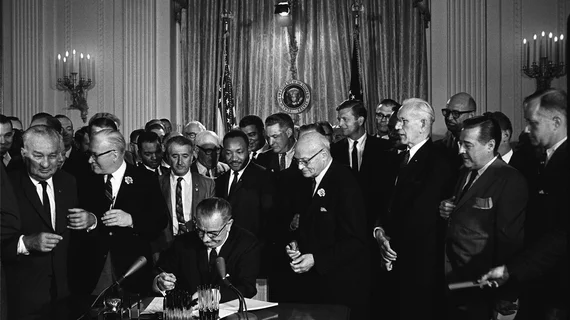The rise and fall of race-based radiation dosing: 4 lessons
Thanks to public outcry and legislative action in 1968, Black patients have not routinely received higher-dose X-rays than their fair-skinned peers for more than half a century.
The story of how U.S. healthcare modernized its ways on the matter is a compelling slice of history. It gets a brief but incisive revisit in an article published Sept. 8 in the New England Journal of Medicine [1].
As recounted there by two Harvard-affiliated professors with expertise in scientific history as well as public health, the episode’s starring cast included consumer advocate and four-time presidential candidate Ralph Nader, with key appearances by the General Electric Company, the American College of Radiology, the American Dental Association and Ladies’ Home Journal.
Also in the picture was the U.S. Public Health Service’s National Center for Radiological Health (a forerunner of today’s CDRH).
In the present NEJM piece, Itai Bavli, PhD, and David Jones, MD, PhD, point out that radiologists and associated healthcare workers continued unilaterally setting X-ray exposure factors for some time after the 1968 shakeup.
For this reason, they write, there’s no way to know how long the practice of adjusting radiation doses for Black people as a group—and doing the same for obese, muscular, cast-wearing, Paget’s disease and other patients—persisted before finally dying out.
The same can be said for groups once believed to require lower-than-normal doses, whose number included slender individuals, children, elderly patients and people with osteoporosis.
In all cases, Bavli and Jones write, “It is not clear which adjustments were based on intuitions or anecdotal experiences and which, if any, were based on careful study.”
With that, Bavli and Jones offer four lessons to mull over from 1968 and, as appropriate, apply in 2023 and beyond.
1. The racialization of the use of the X-ray machine shows how social and medical beliefs (e.g., about the density of skin and bones) become embedded in medical practices and institutions. X-ray technologists and, presumably, medical physicists (Bavli and Jones use the term technicians) were merely following their training when they upped radiation doses for Black patients. More:
This seemingly widespread practice did not generate substantial concern until an outsider brought it to national attention. There is nothing unique about X-rays in this respect: U.S. health professionals have frequently accepted racial logics.”
2. The ubiquity of the misinformed practice demonstrates the problem of focusing on supposed differences between socially defined races and ignoring heterogeneity within them. Recommendations and guidelines suggesting that all Black patients receive increased radiation ignored the range of pigmentation among people who would identify themselves as—or be identified by healthcare workers—as Black, Bavli and Jones note. More:
Ralph Nader cited one anthropologist who asked, ‘How black does one have to be to receive increased dosage?’ This question remains relevant today: Race adjustment is still used uncritically with Black patients in many areas of U.S. medicine” [as in insufficiently trained AI algorithms and discrepancies in morbidity, mortality and vaccination rates exposed during the COVID pandemic].
3. The easy racialization of X-rays highlights the peril of widespread use of race categories. When many existing medical practices treat White as “normal” and adjust for Black people, it seems natural to recommend additional race adjustments, the authors write. The adjustments for X-rays, they add, were introduced even though no compelling evidence had been published to justify them.
Similar changes in medical practice have been made repeatedly, often without adequate justification. … Instead of assuming that differences between socially defined races are significant and widespread, we should subject race-based practices to strict scrutiny, both scientific and ethical.”
4. The 1968 chapter shows how professional societies, in this case the American College of Radiology and American Dental Association, have resisted pressure from outside groups to change their practices. In Nader’s view, a primary interest of the ACR was protecting its autonomy for setting professional standards. “That desire led it to deny a practice that radiologists could have acknowledged and reassessed,” Bavli and Jones write before adding:
To its credit, the ACR was one of the first medical societies to address racial injustice after George Floyd’s murder in May 2020.”
“Fuller knowledge of the harms of simplistic race classifications can help prevent future mistakes with race adjustment,” Bavli and Jones conclude. “Such prevention is no small challenge. Racist biases are often implicit and unnoticed. By continuing to document the misuse of race in medicine, we can help protect patients from medical racism and work toward health justice.”
NEJM has posted the paper in full for free.

